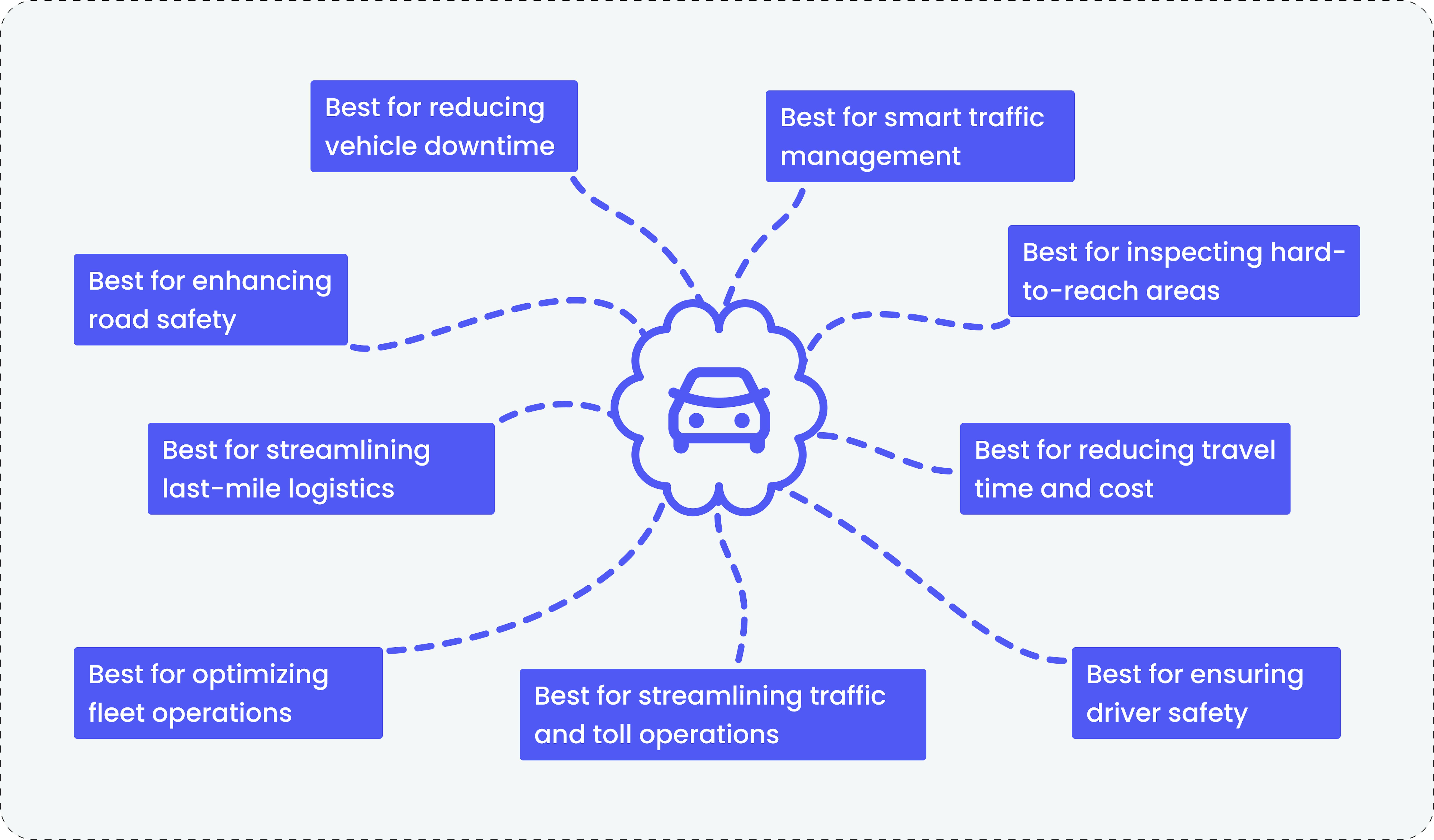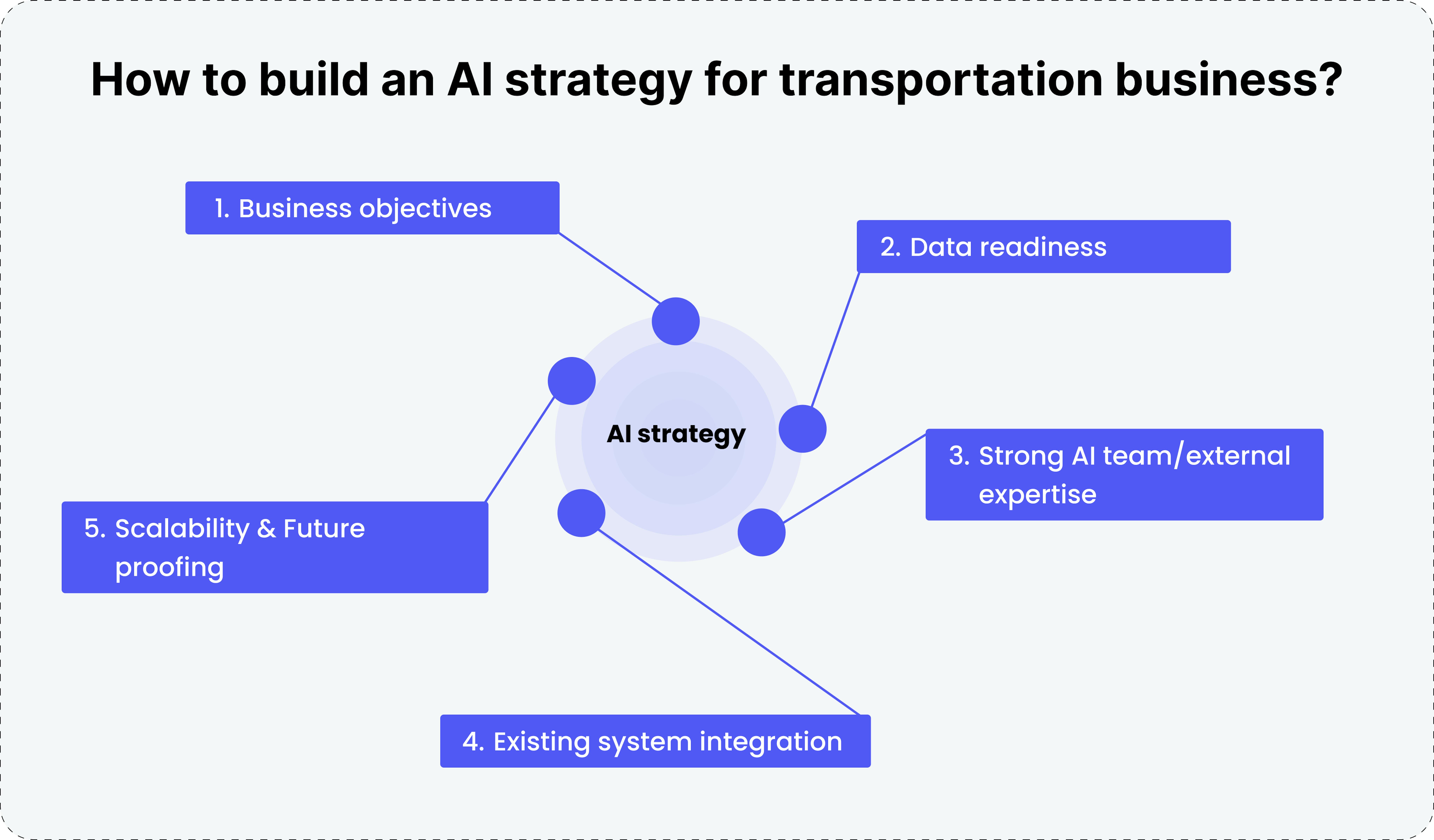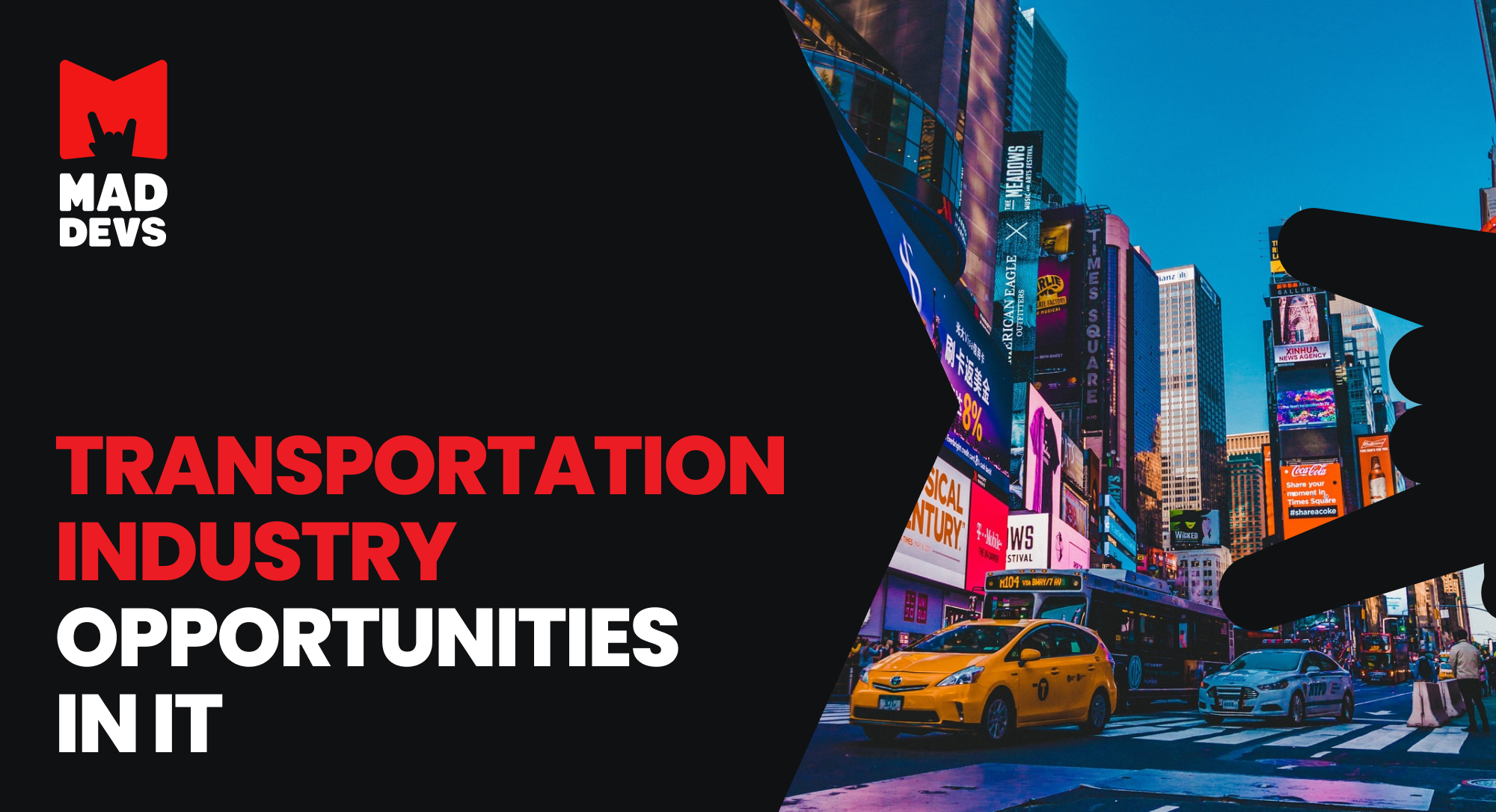The transportation industry, a complex interplay of human factors, economic conditions, and environmental influences, is ripe for innovation. The transportation sector is embracing Artificial Intelligence (AI) with open arms. It is emerging as a powerful tool to optimize this intricate system. By analyzing vast amounts of data, its abilities can predict potential disruptions, improve safety, and enhance overall efficiency.
Let's explore how AI transforms the transportation landscape and makes our daily commutes smoother and more efficient.

AI in transportation: market overview
In 2024, the global market is valued at approximately USD 2.11 billion and is projected to reach USD 6.51 billion by 2031, reflecting a compound annual growth rate (CAGR) of around 17.5% during the forecast period.
Key drivers of growth:
- Autonomous vehicles — Self-driving cars and trucks are poised to transform the transportation landscape. AI-powered vehicles can improve road safety, reduce traffic congestion, and increase fuel efficiency.
- Intelligent traffic management — AI-powered traffic management systems optimize traffic flow, reduce congestion, and improve air quality. These systems use real-time data to identify bottlenecks, reroute traffic, and optimize traffic light timing.
- Logistics optimization — AI-powered logistics solutions streamline supply chain operations, reduce costs, and improve delivery times. AI can optimize route planning, inventory management, and predictive maintenance.
AI in transportation: key applications and examples
Integrating AI in transportation is not just about innovation but practical solutions that enhance safety, efficiency, and cost-effectiveness. From predictive maintenance to advanced route optimization, AI is setting new standards in transportation operations.
Below are some notable applications and real-world examples, of what this technology is good for:

1. Best for reducing vehicle downtime
Maintaining vehicle uptime is critical for efficiency and cost control, but unexpected breakdowns can disrupt operations and lead to significant expenses.
Predictive maintenance leverages AI to analyze sensor data and historical records, identifying when vehicle components require servicing before problems occur. It uses data from IoT devices and machine learning models to monitor equipment health and signal when support is needed, preventing costly failures.
Benefits:
- Reduced downtime and repair costs
- Extended asset life
- Enhanced operational readiness
Key insight: AI-based predictive maintenance requires data preparation and system upgrades, including legacy modernization and data management tools.
Example: Deutsche Bahn implemented AI to digitize maintenance, drastically reducing inspection times and improving reliability.
2. Best for enhancing road safety
Accurate detection and tracking of objects are essential for improving safety and efficiency in transportation systems.
AI-powered object detection and tracking systems utilize deep learning algorithms to identify and monitor moving objects in real-time. The technology uses visual data from cameras to ensure that objects are tracked accurately across frames.
Benefits:
- Improved road safety
- Real-time vehicle tracking
- Enhanced driver assistance features
Example: Volvo's ADAS and Tesla's self-driving capabilities utilize AI for collision avoidance, adaptive cruise control, and pedestrian safety.
3. Best for smart traffic management
Managing transportation networks efficiently is key to reducing congestion, improving safety, and minimizing environmental impact.
Intelligent Transportation Systems (ITS) combine advanced technologies like AI, IoT, and data analytics to optimize traffic flow and decision-making.
These systems analyze real-time data from sensors, cameras, and vehicles to improve decision-making in traffic management, public transit, and logistics.
Benefits:
- Reduced traffic congestion
- Enhanced road safety
- Improved public transit efficiency
- Lower emissions and fuel consumption
Key insight: Implementing ITS requires a robust infrastructure that combines smart sensors, real-time analytics, and AI-powered decision-making systems.
Example: Singapore's Smart Mobility 2030 initiative uses ITS to integrate AI in traffic monitoring, dynamic toll pricing, and public transit scheduling, significantly reducing congestion and travel times.
4. Best for inspecting hard-to-reach areas
Infrastructure inspections and surveillance often require solutions that can navigate challenging or inaccessible areas.
Drones equipped with AI algorithms offer high-resolution imagery and real-time analysis, making them ideal for infrastructure inspections, security surveillance, and traffic management.
Benefits:
- Increased inspection accuracy
- Faster response to incidents
- Lower operational costs
Example: The Port of Rotterdam employs drones to inspect installations, control damage, and respond to incidents.
5. Best for streamlining traffic and toll operations
Managing traffic flow and enforcing regulations require precise and efficient identification of vehicles.
AI-powered license plate recognition (LPR) systems utilize computer vision and deep learning to accurately read and identify vehicle license plates. These systems are commonly applied in traffic law enforcement, toll collection, parking management, and vehicle tracking.
Benefits:
- Enhanced security and surveillance
- Streamlined toll collection and traffic flow
- Improved logistics operations
Example: In New York, an AI-driven LPR system scanned 16 million plates weekly, aiding in the interception of a drug suspect by analyzing route patterns.
6. Best for ensuring driver safety
Maintaining driver focus is crucial for preventing accidents and enhancing road safety.
Driver monitoring systems (DMS) enhanced by AI track driver behavior to detect signs of fatigue, distraction, or unsafe actions. These systems use cameras and AI algorithms to monitor facial expressions, eye movements, and head position, ensuring drivers remain attentive. The data collected can trigger alerts or adjustments to prevent accidents.
Benefits:
- Accurate risk assessment
- Real-time operational insights
- Cost-efficient insurance plans
Example: Cipia partnered with Chery to implement AI-based driver monitoring that detects unsafe actions like seatbelt neglect and phone use.
7. Best for optimizing fleet operations
Efficient fleet management requires real-time insights into vehicle performance, driver behavior, and operational needs.
AI-integrated telematics systems collect and analyze vehicle data to provide insights into performance, driver behavior, and maintenance needs. Combining AI with telematics allows fleet managers to monitor routes, ensure compliance with regulations, and optimize fleet operations. Advanced AI algorithms help predict maintenance needs and provide real-time alerts for route deviations or unauthorized vehicle use.
Benefits:
- Accurate risk assessment
- Real-time operational insights
- Cost-efficient insurance plans
Example: Euristiq developed a cloud-based IoT platform with video telematics for a fleet insurance company, enhancing safety and compliance.
8. Best for reducing travel time and costs
Efficient route planning is essential for minimizing travel time, reducing costs, and improving logistics performance.
AI-powered route optimization goes beyond traditional methods by analyzing multiple variables, including traffic patterns, weather conditions, and road closures. This advanced approach determines the most efficient paths, ensuring timely deliveries, lower fuel consumption, and enhanced operational efficiency.
Benefits:
- Reduced fuel consumption and operational costs
- Enhanced environmental sustainability
- Improved delivery schedules
Example: UPS's ORION system uses AI to save 100 million miles and 10 million gallons of fuel annually.
9. Best for streamlining last-mile logistics
The last mile of delivery is the most complex and costly part of the supply chain, requiring precise planning to ensure efficiency and customer satisfaction.
AI-driven last-mile delivery optimization analyzes real-time traffic, package volumes, and delivery locations to create efficient routes and schedules. This approach reduces costs, improves delivery speed, and enhances customer experience, even in dense urban areas.
Benefits:
- Increased delivery efficiency
- Higher customer satisfaction
- Cost-effective logistics management
Example: Amazon uses AI-driven logistics for efficient last-mile delivery, ensuring timely arrivals even in congested urban areas.
Disadvantages of AI in transportation
While AI promises to revolutionize transportation, it comes with a set of challenges we need to address. Here are some of the main hurdles:
High upfront costs
The initial investment in sensors, software, and hardware can be staggering. This can leave smaller players struggling to keep up, potentially widening the technological divide.
Job displacement
AI excels at automation, but this can come at the cost of human jobs. From drivers and logistics personnel to mechanics, concerns regarding workforce displacement and economic impact are real.
Ethical and liability dilemmas
Accidents involving autonomous vehicles raise complex questions about who's responsible—the manufacturer, the software developer, or even the passenger? And how do we program ethical decision-making into AI for unavoidable crash scenarios?
Cybersecurity concerns
AI systems are vulnerable to attacks that could compromise passenger safety and disrupt entire networks. The very act of collecting mountains of data raises significant privacy concerns as well.
Limited decision-making skills
AI shines in analyzing data and making predictable choices. However, when faced with novel or unpredictable situations requiring human intuition, AI can fall short, potentially leading to inadequate responses.
Resistance to adoption
Fear of job losses, regulatory hurdles, and the need for training can create resistance within organizations and employee populations. Cultural barriers can further impede the acceptance of new technology.
Integration woes
Merging AI with existing infrastructure can be tricky. Compatibility issues between new AI and legacy tech can lead to data-sharing difficulties and operational inefficiencies.
Overreliance on technology
Excessive dependence on AI can be risky. Technical failures could lead to breakdowns or accidents if human oversight is minimized.
Data quality matters
AI relies heavily on clean, accurate data to function effectively. Poor data quality fuels inaccurate predictions and bad decisions that negatively impact operations.
Skilled workforce gap
Finding the talent to manage and maintain these complex AI systems is a challenge. Training existing staff or attracting new talent can be a significant resource drain.
While AI has the potential to enhance transportation, addressing these challenges is critical for its successful and widespread adoption. This is not just about the technology but also about the people and the systems that support it.
Key considerations for an AI strategy
As the transportation industry evolves, more companies are looking to integrate AI. Some aim to keep up with the competition, while others see AI's real value in reducing costs and boosting efficiency. Budget is often a concern, as not all companies are ready to invest heavily in new technologies. But AI doesn't always require massive budgets—when approached strategically, it can deliver impressive results and significant benefits.
AI and machine learning (ML) are key parts of digital transformation; leveraging them effectively can give your business a real edge. However, AI/ML is complex and best handled by experienced professionals. Businesses often struggle with knowledge gaps, so it's wise to consider working with a team of in-house or outsourced experts to develop and implement a successful AI strategy.
Here is a step-by-step guide:

Step 1. Define clear business objectives
- Identify key goals for integrating AI. Can manual processes benefit from automation, leading to better quality and fewer errors?
- Think about how AI can improve your operational workflows, helping you achieve your main business objectives. For example, could AI streamline fleet management or improve route optimization?
Step 2. Assess data readiness
- Evaluate your company's capacity to gather, store, and manage the data necessary for AI.
- Identify potential data sources and consider challenges you may face, such as data integration or quality issues. Clean, well-structured data is essential for effective AI implementation.
Step 3. Build a strong AI team
- Do you have AI/ML expertise within your team, or will you need external support?
- Consider your current resources to support AI implementation and where you might need additional expertise.
💡 Boost your AI team with Mad Devs. Our flexible outstaffing services supply experienced professionals, from ML engineers to data engineers, to help you tackle your most complex AI challenges.
Step 4. Integrate AI into existing systems
- Assess how AI technologies integrate with your IT setup and software systems.
- Anticipate compatibility challenges and make a plan to address any potential integration issues before implementation begins.
Step 5. Scalability and future-proofing
- Can your current infrastructure support the increasing demands of AI as your business grows?
- Ensure your AI solutions are scalable to accommodate future growth so they continue delivering value over time.
Building an AI strategy doesn't have to be overwhelming, and when done thoughtfully, it can provide significant advantages for your business. Let's see the future prospects for AI in transportation for your strategies.
The future of AI in transportation
AI is set to transform transportation, making it safer, more efficient, and more accessible. Ongoing research, technological innovation, and thoughtful policy development will be key to realizing the full potential of AI in this sector.
Here's an overview of current advancements and future prospects:
✔️ Autonomous vehicles
Self-driving cars and trucks are at the forefront of AI in transportation. Companies like Waymo have expanded their driverless ride-hailing services in cities such as Los Angeles, offering 24/7 rides across various neighborhoods. Similarly, Tesla has unveiled the "Cybercab" robotaxi, aiming to introduce these autonomous vehicles by 2027.
✔️ Traffic management
AI-driven systems are optimizing traffic flow and reducing congestion. For instance, AI is being utilized in Sydney to detect and repair potholes before they become problematic, enhancing road safety and maintenance efficiency.
✔️ Public transportation
AI is improving public transit through predictive maintenance, route optimization, and real-time scheduling. According to UITP, nearly 90% of public transportation companies are actively engaged in developing and implementing AI into everyday processes.
✔️ Logistics and freight
AI is streamlining supply chains by optimizing routes, predicting demand, and managing inventories. Autonomous trucks are being tested to enhance long-haul freight efficiency, with companies like Plus leading in autonomous trucking technology.
✔️ Air mobility
The concept of urban air mobility is gaining traction, with AI playing a crucial role in the development of autonomous drones and air taxis. For example, Brisbane is exploring futuristic transport options, such as air taxis and autonomous vehicles, in preparation for the 2032 Olympics.
To wrap up
AI is driving remarkable transformations in transportation, from autonomous vehicles to optimized logistics, and the future holds even greater potential. However, adopting AI requires careful planning, robust data strategies, and the right talent to overcome challenges like cybersecurity, integration, and ethical concerns.
If you need assistance implementing AI in the transportation sector, Mad Devs is your trusted partner. We offer solutions that make your business safer, more efficient, and tech-driven. Learn more about our ML services and contact us for a consultation.











